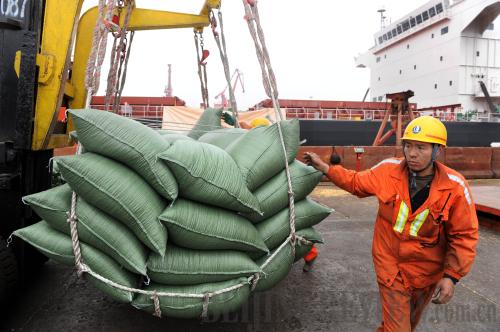|
 |
|
IMPORT BOOM: Workers offload soybeans imported from the United States at Qingdao Port, Shandong Province, on February 18, 2011. In January, China imported 5.14 million tons of soybeans, up 26 percent year on year (LI ZIHENG) |
As China gears up to rebalance its economy, a key factor will be weaning its reliance on exports. The vigorous efforts are paying off as the country reported a trade deficit in the first quarter of this year.
China recorded a trade deficit of $1.02 billion between January and March this year, the first quarterly trade deficit in six years, said the General Administration of Customs (GAC). Earlier, China experienced quarterly trade deficits in the first quarters of 2003 and 2004.
Exports climbed 26.5 percent year on year to $399.64 billion for the first quarter of this year, while imports hit $400.66 billion, up 32.6 percent from the previous year.
The European Union remained China's largest trade partner, followed by the United States and the Association of Southeast Asian Nations.
Zheng Yuesheng, Director of the Statistical Department of the GAC, said China imported more mechanical and electrical equipment, as well as cars, iron ores and soybeans than it did in the same period a year ago and that the prices of those commodities had all increased. Meanwhile, the Spring Festival holiday, which fell on February 2-8 this year, also helped shore up imports.
In March alone, the country's foreign trade amounted to $304.26 billion, soaring 31.4 percent from a year ago. Of this total, exports edged up 35.8 percent year on year to $152.2 billion, while imports hit a record monthly high of $152.06 billion, up 27.3 percent. The March trade deficit came in at $140 million.
The cause
Lu Zhiming, a researcher at the Financial Research Center of the Bank of Communications, pointed to three major reasons for buoyant imports.
"Due to a relatively lower comparison base of last year, import growth picked up this year," Lu told Economic Information Daily.
China's imports rose $48.02 billion in March month on month this year, against $32.44 billion in the same period of 2010.
"A number of factories restarted manufacturing machines after the Spring Festival, delivering a boost to demands for commodities," he said. "In addition, international commodity prices are on the rise. The crude oil price, in particular, is creeping higher due to the confrontation in Libya," he added.
China's iron ore imports soared 14.4 percent to 177 million tons in the first three months of this year, while the average price rose by 59.5 percent year on year. The average price of imported soybeans also went up 25.7 percent from a year earlier to $57.39 per ton in March, said the GAC.
Li Huiyong, a senior analyst with the Shenyin & Wanguo Securities Co. Ltd., said a handful of policy incentives also encouraged imports as the country rolled up its sleeves to rebalance the foreign trade sector.
In recent years, China has adopted a series of measures to stimulate imports, including lower import tariffs, easier customs entry, financing support to importers and subsidies to imports of hi-tech equipment, said Zuo Xiaolei, chief economist at the China Galaxy Securities Co. Ltd.
In 2009, China replaced Germany as the world's second largest importer, behind only the United States.
There is no need to worry about the trade deficits given the country's deep foreign exchange reserves, said Li Daokui, member of the Monetary Policy Committee of the People's Bank of China and Director of the Center for China in the World Economy at Tsinghua University. It should also help ease pressure for the country to appreciate the yuan, he said.
Surplus shrinks
Economists believe China can still reap a trade surplus for the entire year, though it may shrink.
Zheng of the GAC said the quarterly deficit is only temporary.
"China will remain a surplus trader this year thanks to its strong manufacturing strength and competitive edge of its exports," he said.
Mei Xinyu, an associate researcher with the Chinese Academy of International Trade and Economic Cooperation of the Ministry of Commerce (MOFCOM), agreed. "China's exporters are regaining their lost ground, drawing strength from the recovery of Western markets," Mei told Beijing Review.
With imported hi-tech equipment, Chinese manufacturers are more able to upgrade their products and increase exports, said Mei.
"The surplus, however, is bound to decrease as global commodity prices continue heading north," said Lu Zhengwei, chief economist with the Industrial Bank Ltd.
Global economic recovery and massive monetary expansion in the developed economies are the biggest drivers of price surges, he said.
| 